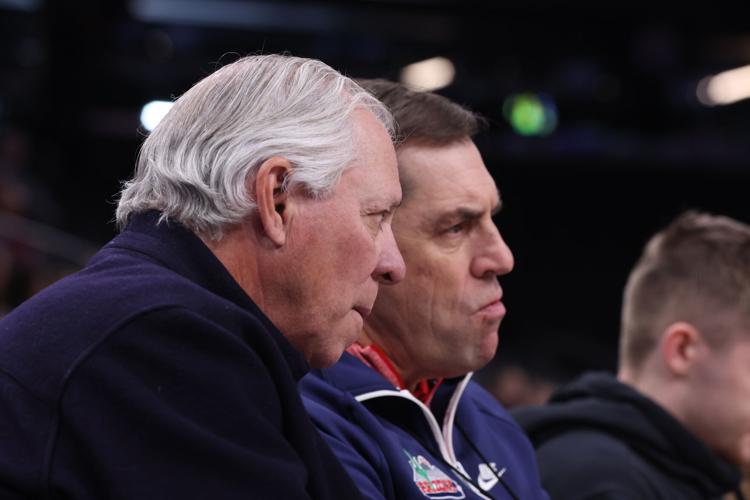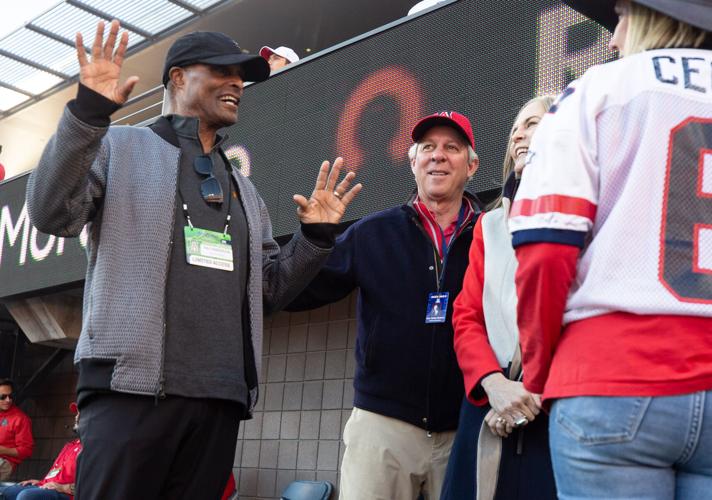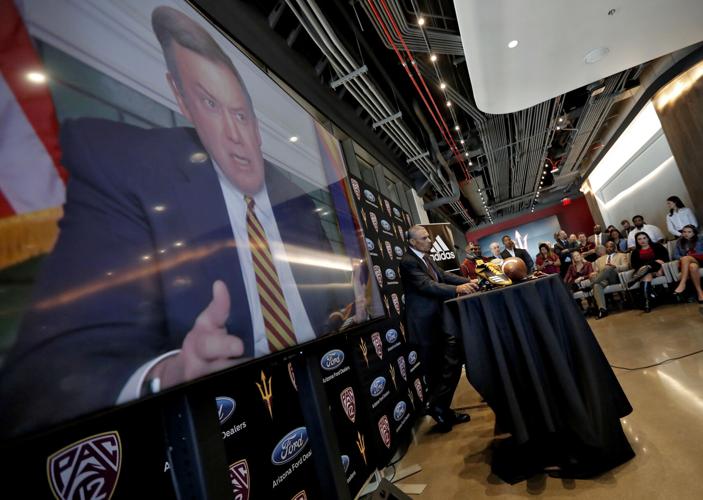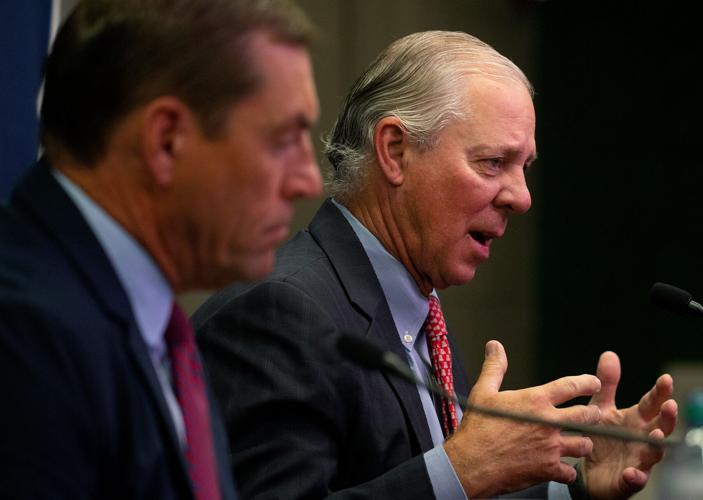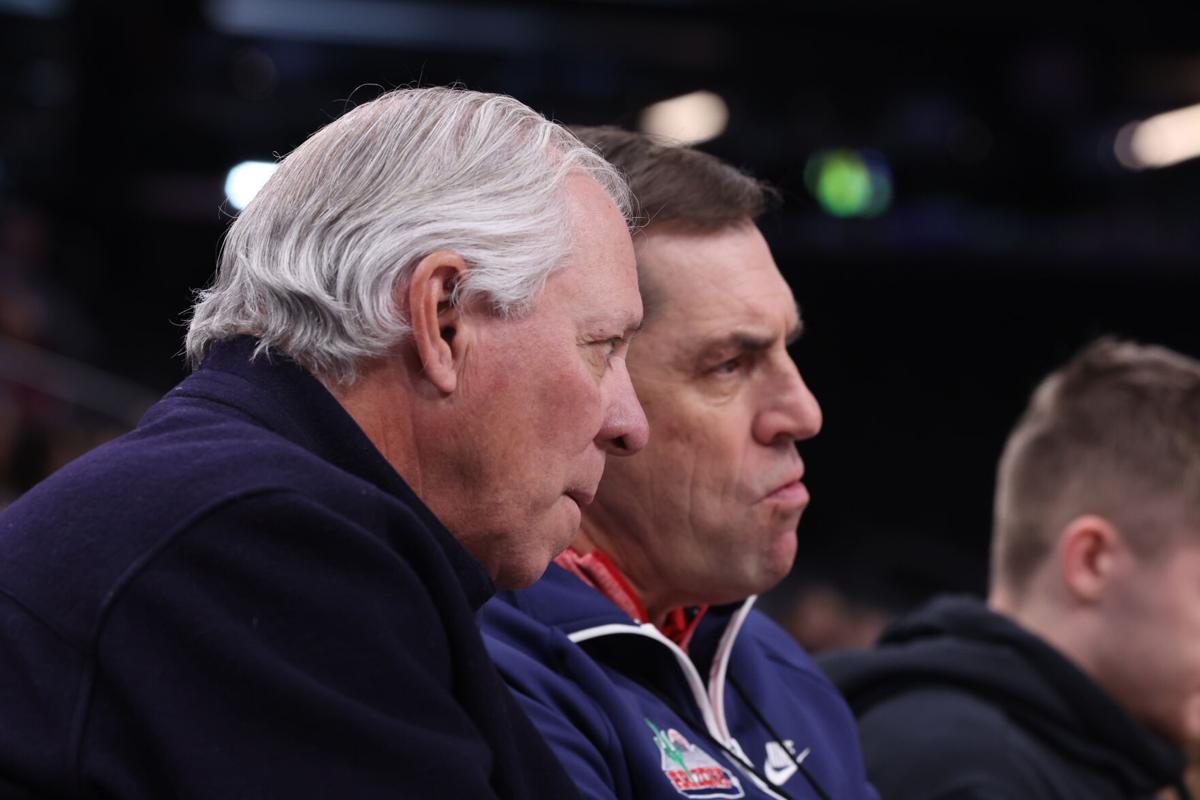Arizona’s news-making month continued Monday when the school announced it will part ways with athletic director Dave Heeke — a major development surprising for the timing more so than the decision itself.
One week ago, Heeke and the Wildcats hired a new football coach.
Welcome to town, Brent Brennan — and, by the way, you’re getting a new boss.
The leadership change in Tucson means both Arizona schools have vacancies at the top of their athletic departments following serious, albeit quite different, missteps.
Arizona State’s Ray Anderson stepped down in November after the disastrous hiring of football coach Herm Edwards, the subsequent NCAA recruiting violations and the self-imposed bowl ban for the 2023 season.
Arizona’s problems under Heeke were largely fiscal in nature: The athletic department rang up enough debt to cover the Sonoran Desert and exacerbated a university-wide financial crisis.

Then-ASU athletic director Ray Anderson and University of Arizona president Robert Robbins greet each other during the Arizona State at Arizona football at Arizona Stadium on Nov. 25, 2022.
As the schools prepare for entry into the Big 12 this summer, they have leadership voids to navigate and searches to undertake.

ASU president Michael Crow
They share a state, a conference and a university system but are nothing alike in two ways that will shape the pursuits: department funding models and university presidents.
Arizona’s Robert Robbins has taken a hands-on approach to athletics — to the point that he’s viewed throughout college sports as the Wildcats’ de facto athletic director.
ASU’s Michael Crow is considered the antithesis, a president deeply disengaged from athletics.
Any prospective candidates in Tucson or Tempe will be keenly aware of those reputations — and the possibility of leadership changes on both campuses.
Crow is 68. How long will he stick around? Is there a succession plan? If Crow steps down in the next few years, will ASU’s chief operating officer Chris Howard slide into the big chair?
Retirement isn’t the primary issue with the 66-year-old Robbins. Job security is. In November, the school revealed what could loosely be described as a $240 million accounting error that sparked a financial crisis.
The university CFO was fired in December.
Now, Heeke has been ousted.
Robbins is holding others accountable. Will the Arizona Board of Regents do the same to him or allow Robbins to direct the purge and subsequent recovery?
And to what extent will the Wildcats’ cash crunch impact athletic department funding in the future?
In both Tucson and Tempe, the AD searches must be about the future: The transition into the Big 12 ... the momentous legal challenges to the NCAA’s economic model ... the continued consolidation of football power around the Big Ten and SEC ... and the potential bifurcation of major college football into a mini-NFL stocked with blue-bloods and complementary regional leagues for everyone else.
ASU and Arizona must position themselves to thrive. Without a solid financial foundation, success in the Big 12 — and whatever might come after the Big 12 — isn’t possible.
In that regard, the schools have wildly different DNA. Despite the shared board of regents, ASU and Arizona aren’t even fraternal twins. They are more like first cousins.

Herm Edwards, at podium, listens as ASU president Michael Crow speaks via video during a news conference after the university's announcement of Edwards as its new football coach on Dec. 4, 2017, in Tempe.
ASU’s massive online education program (approximately 60,000 students) supports a business plan that allows central campus to provide substantial direct support to athletics. Arizona simply doesn’t have that kind of cash.
The funding models on each campus were disrupted across multiple fiscal years by COVID — and that disruption is still rippling through the system.
But if we use the pre-pandemic numbers over five fiscal years as a guide to potential support levels moving forward, the disparity is clear:
ASU athletics received an average of $23 million in campus support (approximately).
Arizona athletics collected an average of $13 million from central campus.
(Note: Figures taken from USA Today’s database on college athletic finances.)
The disparity is more likely to grow than shrink if the fiscal crisis in Tucson forces Robbins and his next athletic director to make cuts that won’t exist for Crow and his hire — assuming, of course, that Robbins and Crow are still on the job in the second half of the decade.

University of Arizona President Robert C. Robbins, right, and athletic director Dave Heeke speak during a press conference on Aug. 7 at Arizona Stadium about the UA’s move from the Pac-12 to the Big 12.
Which AD position is more coveted across major college sports?
There are too many unknowns with each position to draw definitive conclusions, but the Hotline surveyed a handful of industry experts.
Arizona was given the advantage in lifestyle, community support and the presence of a big-brand basketball program in one of the major revenue sports. But Robbins’ hands-on management style was seen as a possible drawback, in addition to the financial crisis.
Arizona State was favored by some because of the deep well of support from central campus — that includes the AD compensation package, by the way — and the location. (Phoenix is a major media market and blossoming recruiting hub.)
But the Sun Devils are forever struggling to gain traction in a pro market. They have a major unresolved NCAA scandal lingering, and Crow’s industry reputation — he fashions himself an expert in college sports — could prove a turn-off.
Neither school is likely to generate interest from established athletic directors in the Big Ten or SEC, while sitting ADs in the Big 12 and ACC might view Tempe and Tucson as lateral moves.
Especially with so much uncertainty on both campuses.
“We thought the future was gonna be brighter as a member of the Big 12. … I think this is a very exciting deal for us.” — Arizona president Robert Robbins; Video by Justin Spears/Arizona Daily Star


